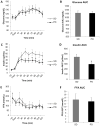Pilot Study of Impact of a Pedal Desk on Postprandial Responses in Sedentary Workers
- PMID: 29864080
- PMCID: PMC6138546
- DOI: 10.1249/MSS.0000000000001679
Pilot Study of Impact of a Pedal Desk on Postprandial Responses in Sedentary Workers
Abstract
Physical inactivity has been linked to rates of obesity, diabetes, and heart disease through insulin resistance and other mechanisms. Although sedentary workplace environments have unintentionally contributed to the risk for chronic diseases, innovations in the workplace environment could potentially rectify this public and occupational health problem.
Purpose: To evaluate the effects of light-intensity physical activity using a pedal desk (PD) compared with a standard desk (STD) in a pilot study on postprandial metabolic responses and work skills.
Methods: Twelve overweight/obese full-time sedentary office workers (six men and six women; body mass index, 28.7 ± 3.6 kg·m) were tested in two conditions: 1) PD, pedaling at self-selected light-intensity pace for 2 h and 2) STD, remaining seated for 2 h in a conventional workstation setup while performing scripted computer-based work tasks. Blood samples were analyzed for plasma glucose, insulin, and free-fatty acids in response to a standardized meal and work skills were evaluated. Paired samples t-tests were used to examine the differences in metabolic responses and work performance tasks between the conditions.
Results: Pedal desk use required significantly less insulin to maintain glucose concentrations compared with STD condition (peak insulin concentration, 42.1 μU·mL vs 66.9 μU·mL; P = 0.03; and area under the curve, 302.6 vs 441.8 μU·min·mL; P < 0.001). No significant changes in plasma glucose and free-fatty acid concentrations were observed at any timepoints (all P > 0.05). In addition, pedaling at a self-paced rate caused no adverse effects on work skills (P > 0.05).
Conclusions: The PD resulted in lower postmeal insulin concentrations without an overall negative impact on work skills. Thus, the PD could have the potential to achieve public and occupational health goals in sedentary work environments.
Conflict of interest statement
The authors declare they have no financial conflicts of interest. Dr. Catrine Tudor-Locke and Mr. Gerald R. Locke, co- invented and thus own intellectual property for the Pennington Pedal Desk™. A management plan was established for financial conflicts of interest that included electronic data capture, a third party audit of the data and manuscript, and designation of Dr. Stuart Chipkin as the Principal Investigator who managed the study. Dr. Tudor-Locke did not determine study design and had no contact with study participants or study data. None of the other authors have a potential conflict of interest. The results of the resent study do not constitute endorsement by the American College of Sports Medicine. The results of the study are presented clearly, honestly, and without fabrication, falsification, or inappropriate data manipulation.
Figures


Similar articles
-
Alternating bouts of sitting and standing attenuate postprandial glucose responses.Med Sci Sports Exerc. 2014 Nov;46(11):2053-61. doi: 10.1249/MSS.0000000000000337. Med Sci Sports Exerc. 2014. PMID: 24637345 Clinical Trial.
-
Workplace Strategies to Prevent Sitting-induced Endothelial Dysfunction.Med Sci Sports Exerc. 2018 Apr;50(4):801-808. doi: 10.1249/MSS.0000000000001484. Med Sci Sports Exerc. 2018. PMID: 29117072 Clinical Trial.
-
Effects of subtracting sitting versus adding exercise on glycemic control and variability in sedentary office workers.Appl Physiol Nutr Metab. 2014 Nov;39(11):1286-93. doi: 10.1139/apnm-2014-0157. Epub 2014 Jul 21. Appl Physiol Nutr Metab. 2014. PMID: 25166626
-
The Acute Metabolic and Vascular Impact of Interrupting Prolonged Sitting: A Systematic Review and Meta-Analysis.Sports Med. 2018 Oct;48(10):2347-2366. doi: 10.1007/s40279-018-0963-8. Sports Med. 2018. PMID: 30078066
-
Effects of cycle and treadmill desks on energy expenditure and cardiometabolic parameters in sedentary workers: review and meta-analysis.Int J Occup Saf Ergon. 2021 Sep;27(3):728-736. doi: 10.1080/10803548.2018.1562688. Epub 2019 Feb 7. Int J Occup Saf Ergon. 2021. PMID: 30595127 Review.
Cited by
-
Effect of an office-based intervention on visceral adipose tissue: the WorkACTIVE-P randomized controlled trial.Appl Physiol Nutr Metab. 2021 Feb;46(2):117-125. doi: 10.1139/apnm-2020-0175. Epub 2021 Jan 15. Appl Physiol Nutr Metab. 2021. PMID: 33451268 Free PMC article. Clinical Trial.
-
Physiological processes induced by different types of physical activity that either oppose or enhance postprandial glucose tolerance.Front Endocrinol (Lausanne). 2025 Jul 4;16:1601474. doi: 10.3389/fendo.2025.1601474. eCollection 2025. Front Endocrinol (Lausanne). 2025. PMID: 40687587 Free PMC article. Review.
-
Effects of Bluetooth-Enabled Desk Ellipticals on Office Work Performance: Rationale, Design, and Protocol for a Randomized Trial With Overweight and Obese Adults.JMIR Res Protoc. 2020 Jan 14;9(1):e16275. doi: 10.2196/16275. JMIR Res Protoc. 2020. PMID: 31934871 Free PMC article.
References
-
- Mayer-Davis EJ, D’Agostino R, Jr, Karter AJ, Haffner SM, Rewers MJ, Saad M, et al. Intensity and amount of physical activity in relation to insulin sensitivity: the Insulin Resistance Atherosclerosis Study. JAMA. 1998;279(9):669–74. Epub 1998/03/13. - PubMed
-
- Larsen RN, Kingwell BA, Robinson C, Hammond L, Cerin E, Shaw JE, et al. Breaking up of prolonged sitting over three days sustains, but does not enhance, lowering of postprandial plasma glucose and insulin in overweight and obese adults. Clin Sci (Lond) 2015;129(2):117–27. doi: 10.1042/cs20140790. Epub 2015/03/04. - DOI - PubMed
Publication types
MeSH terms
Substances
Grants and funding
LinkOut - more resources
Full Text Sources
Other Literature Sources
Medical
Research Materials

